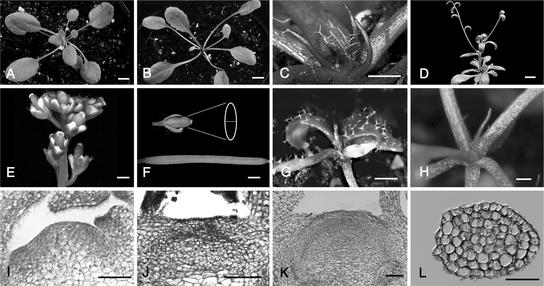Figure 1.
Development of drn-D Mutants and Comparison with Transgenic 35S::DRN/ESR1 and 35S::DRN/ESR1-GR Plants.
(A) Wild-type Arabidopsis seedling.
(B) drn-D mutant seedling at 20 DAG. The shoot meristem has lost activity after the development of seven leaves.
(C) Close-up of the drn-D apex in (B). Filamentous organs surround the enlarged meristem.
(D) drn-D inflorescence originating from an axillary meristem with a characteristic stop-and-go phenotype. The primary inflorescence meristem arrests, and axillary shoots grow out.
(E) Most drn-D plants develop stunted flowers after initiating numerous cauline leaves and several stop-and-go cycles.
(F) Siliques of drn-D mutants (top) are shorter and broader than wild-type siliques (bottom).
(G) Phenotype of a class-1 35S::DRN/ESR1 seedling. The SAM is arrested after the development of a single filament.
(H) 35S::DRN/ESR1-GR T2 plant at 7 days after dexamethasone treatment. SAM activity stops after the development of a single radialized organ.
(I) to (K) Dellafield staining of longitudinal sections through wild-type (I) and drn-D shoot meristems at two developmental stages ([J] and [K]). In the early seedling (6 DAG), the meristem is still active and initiates three to four additional leaves (J), whereas the late (20 DAG) drn-D SAM has stopped activity (K). A single filament is sectioned to the right of the apex. Note the size increase in the early and late drn-D SAM relative to the wild-type SAM. The characteristic L1, L2, and L3 layering is lost already in the early (6 DAG) seedling, although the SAM remains active.
(L) Dellafield-stained cross-section through a filamentous organ that appears fully radialized.
Bars = 5 mm in (A) and (B), 1 mm in (C) and (E) to (H), 10 mm in (D), and 100 μm in (I) to (L).

